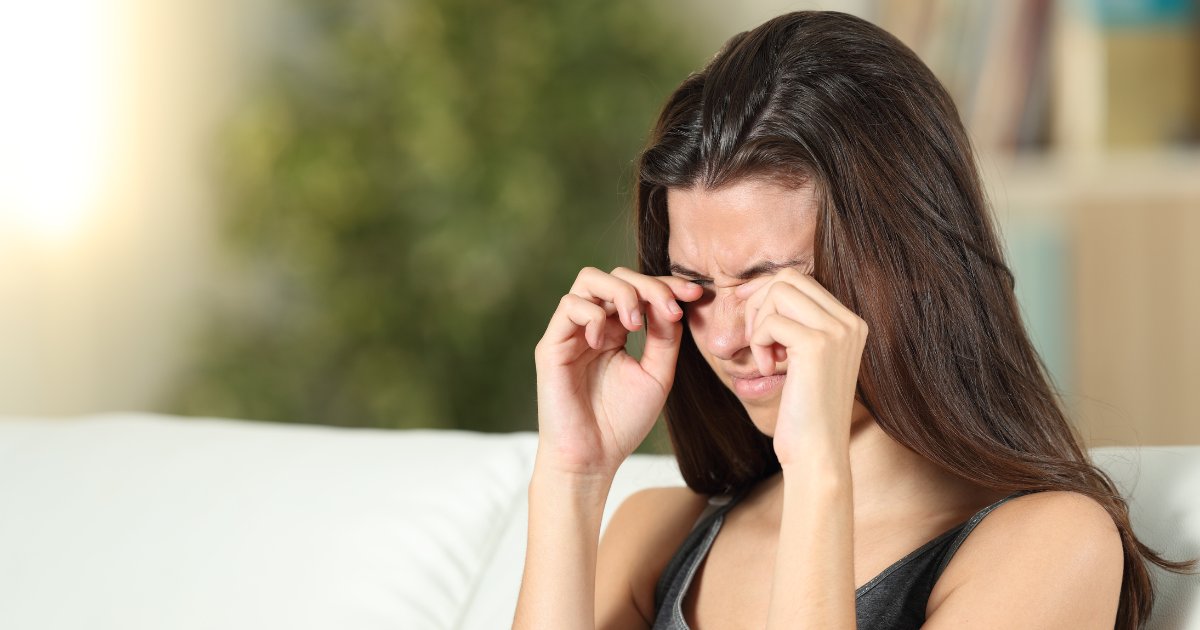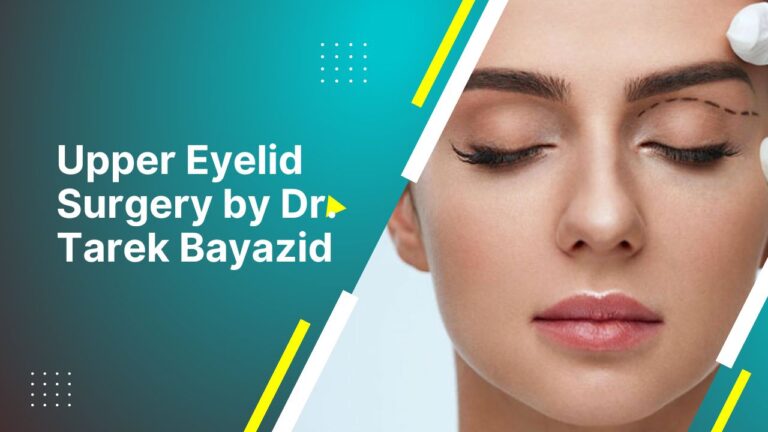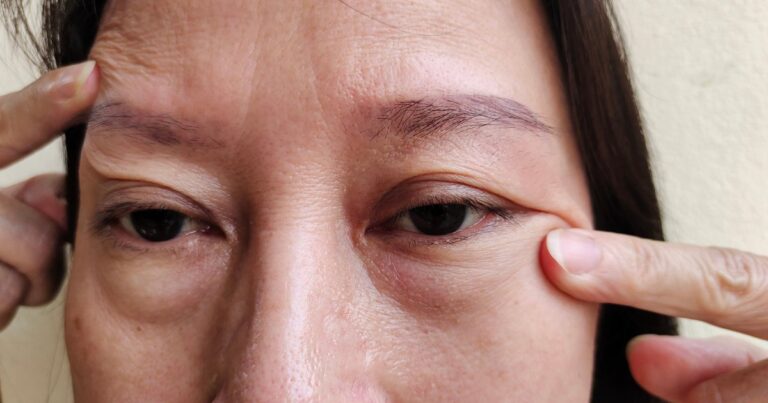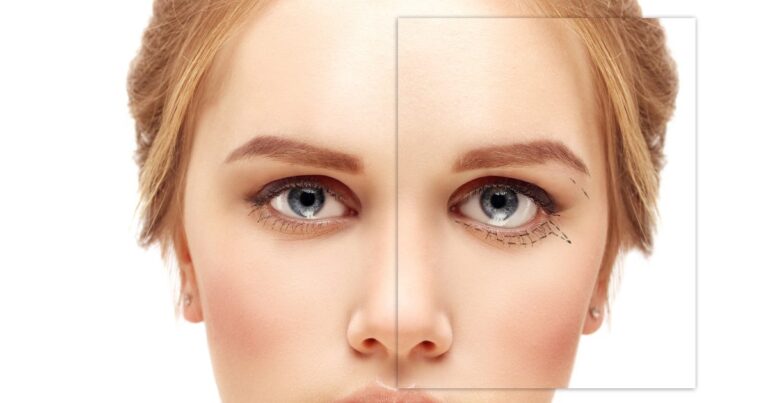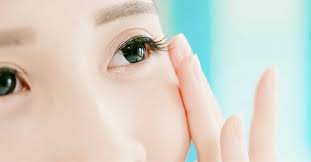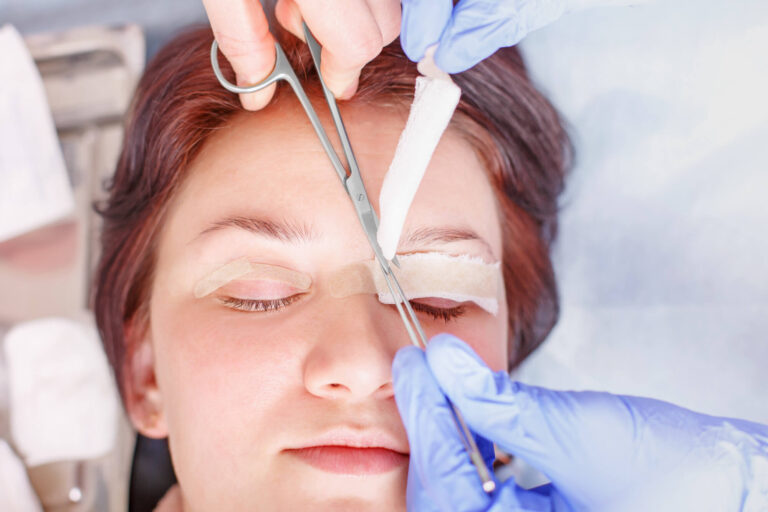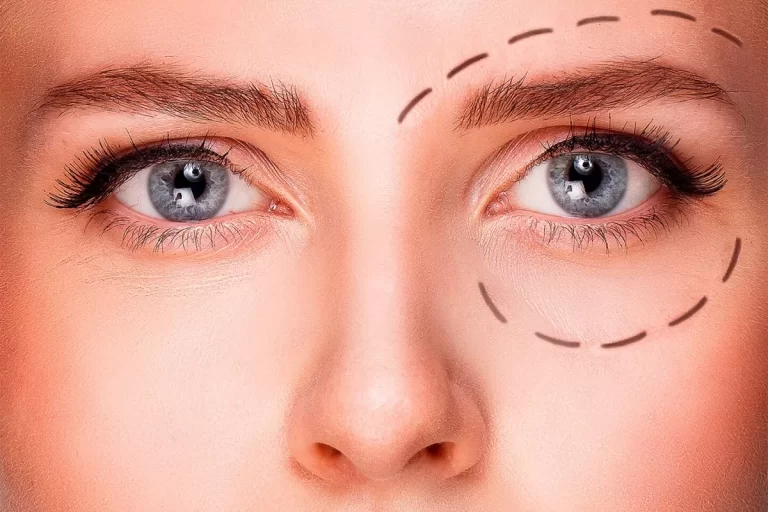Eyelid surgery, also known as blepharoplasty, is a cosmetic procedure to remove excess skin, muscle, and fat from the upper and lower eyelids. It can give you a more rested, youthful appearance and improve peripheral vision obstructed by sagging eyelids. However, as with any surgery, blepharoplasty carries certain risks, one of them being dry eyes.
Eyelid Surgery And Dry Eyes are common postoperative complications, with studies showing an incidence rate ranging from 9% to 75% after blepharoplasty. Dry eyes after eyelid surgery may only be temporary for some patients, while for others, it can become chronic and impact their quality of life. So, before you decide to get a blepharoplasty, you must understand the correlation between the two and the steps you can take to prevent severe dryness after the procedure.
What Causes Dry Eyes After Eyelid Surgery?
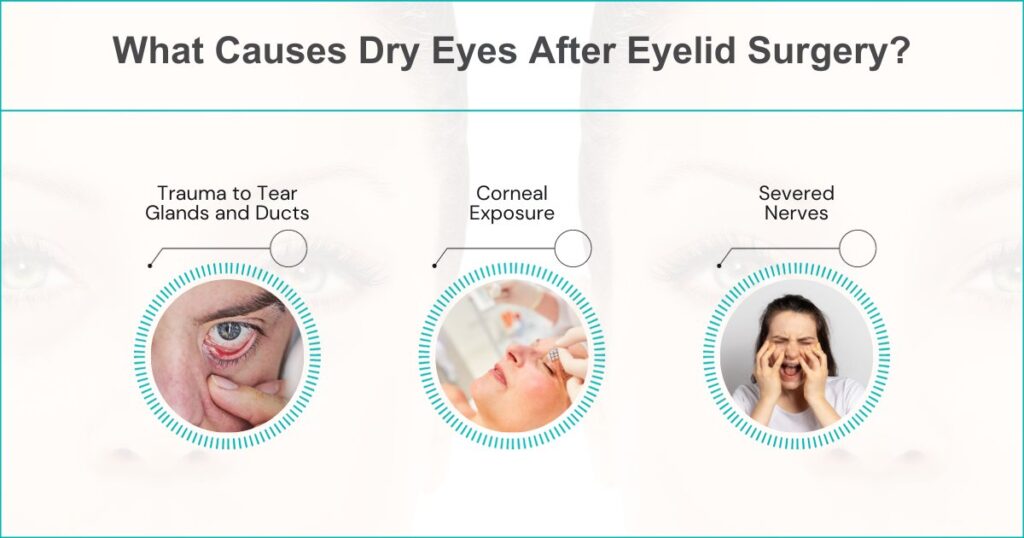
Several factors during and after blepharoplasty can disrupt tear production and eye moisture levels, bringing about dry, irritated eyes. These include:
Trauma to Tear Glands and Ducts
- The lacrimal glands, which produce the watery component of your tears, sit in the upper outer corner of the orbit bone surrounding your eye.
- During blepharoplasty surgery, especially if skin, muscle, or fat are removed from the upper lids, the gland or its ducts may inadvertently get damaged.
- This impairs tear secretion, particularly if there is scarring around the lacrimal gland area post-surgery.
Corneal Exposure
- Removing excess upper or lower eyelid tissues can change lid closure and corneal coverage dynamics.
- If your lids no longer close fully or do an incomplete blink, it leaves more corneal surface area exposed. This increases tear film evaporation and dry eye symptoms like stinging, blurry vision, and redness.
Severed Nerves
- Branches of the trigeminal nerve innervate the cornea, providing corneal sensation, regulating tear production, and initiating the blink reflex.
- If small nerve endings are inadvertently cut during blepharoplasty, it can make your eyes drier. Damaged corneal nerves may not sense dryness accurately or signal your brain to produce more tears through the reflex arc.
| Cause of Dry Eyes | Description |
| Trauma to tear glands/ducts | Impaired tear production |
| Greater corneal exposure | More tear evaporation |
| Severed corneal nerve endings | Reduced corneal sensation, decreased blink response and tear secretion |
Factors that Increase Your Risk of Chronic Dry Eye Problems After Blepharoplasty
While many patients experience some dry eye symptoms immediately after eyelid surgery, certain factors predispose you to lasting, persistent dryness or make transient dryness worse. These patient-related and procedural risk factors include:
Patient-Related Risk Factors
- Prior dry eye disease or blepharitis: Having pre-existing dry eyes or eyelid inflammation means your tear production and eye moisture levels are already suboptimal. The surgery may exacerbate the problem.
- Advancing age: Tear production steadily declines with age. Older patients have comparatively lower baseline lacrimal gland function.
- Female sex: Hormone changes after menopause further increase dry eye risk in older women.
- Previous eye surgery: Prior LASIK, cataract surgery, or other ocular procedures like retinal detachment repair increase vulnerability for post-blepharoplasty dryness due to pre-existing nerve damage.
- Systemic conditions: Autoimmune disorders like rheumatoid arthritis, lupus, thyroid disorders, Parkinson’s disease or Sjogren’s syndrome are linked to increased dry eye disease risk.
Surgical Risk Factors
- Upper blepharoplasty: This has a stronger association with dry eyes than isolated lower lid blepharoplasty, as the upper lacrimal glands lie closer to the surgical field. Any trauma to the glands during surgery can directly impact tear production.
- Skin excision techniques: Skin-muscle flap elevation techniques have a higher risk of damaging deeper lacrimal gland lobules or ducts versus removing skin and fat alone. Skin shortage after blepharoplasty may also cause lid retraction.
- Concurrent midface lift: Combining eyelid surgery with lifting of the midface soft tissues places the lacrimal gland and connecting nerves at higher risk for incidental damage.
| Patient-Related Risk Factors | Surgical Risk Factors |
| Prior dry eye/blepharitis | Upper Blepharoplasty |
| Older age | Skin excision techniques |
| Female sex | Concurrent midface lift |
| Previous eye surgery | |
| Autoimmune disease |
Signs and Symptoms of After Eyelid Surgery And Dry Eyes
How do you know if you are experiencing problematic dryness rather than normal post-op irritation that gradually improves? Key indicators include:
Book A Consultation With Dr Tarek Bayazid
Top-rated Plastic Surgeon For Eyelid Surgery in Dubai
Installment Plan Available
- Constant stinging, burning, watery eyes lasting longer than six weeks
- Blurry, fluctuating vision and trouble seeing fine details
- Mucus strands in tear film
- Need for frequent artificial tear use 4-6 times a day minimum
- Red or pink eye whites/lids
- Light sensitivity/eye fatigue
- The feeling of something being stuck in your eye
- Recurrent eye infections or styes
These chronic symptoms signify impaired tear film stability and ocular surface damage from excessive dryness. When recognised early, doctors can take steps to mitigate complications. But if treatment gets delayed, it can lead to permanent corneal ulceration and vision loss in rare cases.
Medical Treatment for After Eyelid Surgery And Dry Eyes
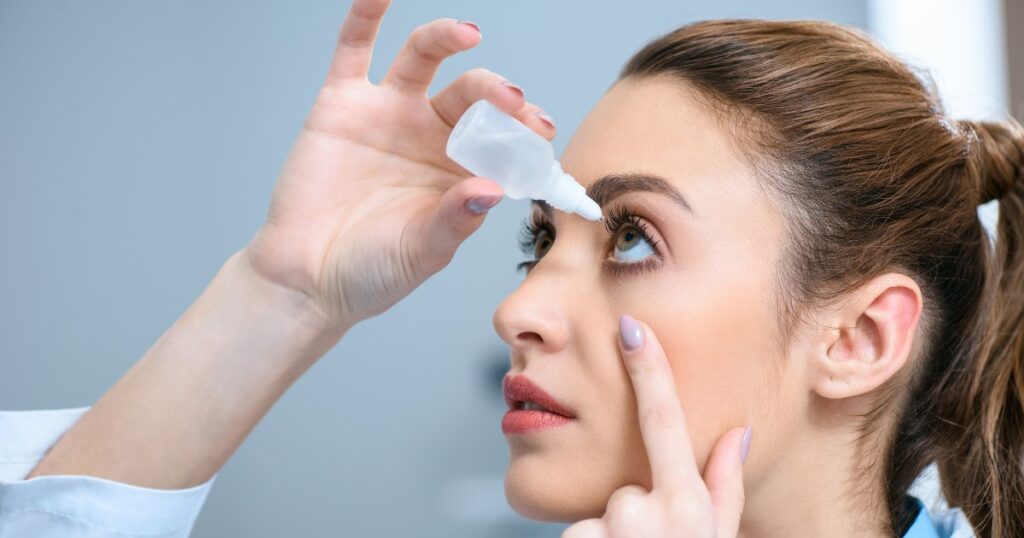
Managing dry eye disease after eyelid surgery centres around rebuilding and preserving existing tear film and lubricating the ocular surface. Typical treatment measures include:
Aggressive Artificial Tear Replacement
Frequent use of preservative-free artificial tear drops and gels up to 4-6 times a day is the mainstay of treatment. This augments tear volume provides moisture, and stabilises the tear film, minimising evaporation-related damage.
Lacrimal Plugs
These tiny devices sit in your drainage ducts, mechanically blocking tear outflow. By keeping more of your natural tears on the eye surface longer they help ease dryness. Steroid-eluting punctal plugs also gradually release anti-inflammatory medication.
Prescription Anti-inflammatory Eye Drops
Steroids, antibiotics, or other eye drops reduce lid margin and ocular surface inflammation due to dryness. This helps relieve symptoms and optimise tear production of remaining functional lacrimal and accessory gland tissue. Doctors closely monitor for side effects like infection or elevated eye pressure.
Moisture Chamber Glasses
Wrap-around glasses create a humid mini-environment, preventing tear evaporation. Constant moisture helps the epithelial cells lining your cornea and conjunctiva heal if damaged.
In more serious cases, prescription medications taken orally, like Restasis or Xiidra, provide immune-modulating effects. They reduce inflammation and stimulate tear production from residual gland tissue.
Autologous serum eye drops from your blood or surgical interventions like punctual occlusion, or moisture chamber LASIK eyeglasses implants may benefit patients with intractable dry eye problems not responding to other measures. The key is starting conservative dry eye therapy as soon as impaired tear film is recognised post-blepharoplasty rather than watching symptoms fester for too long.
6 Ways to Prevent Dry Eyes After Eyelid Surgery
The good news is with proper precautions before and after blepharoplasty, complications like chronic dry eye can often be avoided. Useful prophylactic strategies include:
- Rigorously screening candidates: Identify predisposing dry eye disease through slit lamp exams, tear film stability tests, and dry eye symptom surveys. Weigh risks versus aesthetic benefits.
- Preoperative treatment: Prescribe aggressive artificial tears, eyelid hygiene, and warm compresses for ≥2 weeks before surgery if you have glaring dry eye signs.
- Intraoperative precision: Employ meticulous dissection techniques, avoiding trauma near the lacrimal gland duct openings.
- Lubricating eye ointments: Place thick lubricating ointment inside the lower fornix for one-week post-surgery to minimise surface irritation—Taper slowly only after complete epithelialisation.
- Temporary eyelid closure: Partial suturing of upper eyelids closed for 5-7 days post-op reduces tear evaporation until the cornea and conjunctiva epithelia heal.
- Early intervention: Have an extremely low threshold to start medical management at the slightest hint of persistent dryness symptoms after blepharoplasty rather than taking the “wait and see” approach.
The correlation between ‘Eyelid Surgery and Dry Eyes’ is a critical aspect to consider. While eyelid surgery can offer aesthetic and functional improvements, it’s essential to be aware of the potential for dry eyes as a postoperative condition. Patients should discuss this with their surgeon and plan for appropriate management to ensure the best possible outcome from the surgery.
If sagging upper eyelids make you look old and tired or interfere with your vision, blepharoplasty may help. But like any surgery, it pays to find an experienced oculoplastic surgeon focused on safety and precision.
As one of Dubai’s most trusted eyelid specialists, Dr Tarek Bayazid has the expertise to deliver predictable results after blepharoplasty – including minimising adverse events like post-op dry eye disease. With attention to detail and patient-centric care, he strives to help you achieve your cosmetic eyelid goals safely.
To learn more about blepharoplasty and reducing surgical risks, book a consultation with Dr. Tarek Bayazid today.
